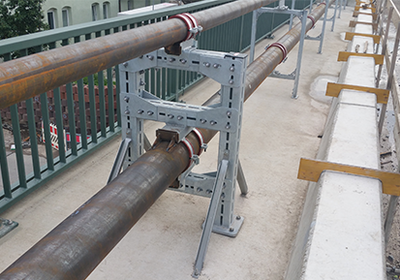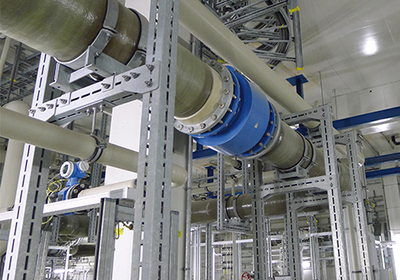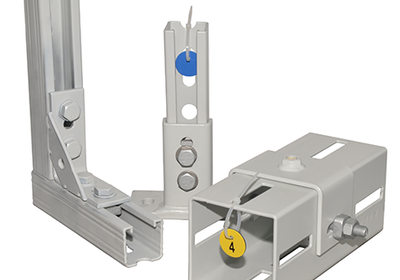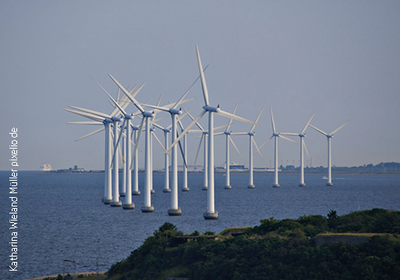Tailor-made corrosion protection for pipeline fastenings
04 August 2022 , Volker Weber, product manager
Steel is the main material used in fastening technology. It is inexpensive, easy to process and completely recyclable. However, in order to effectively prevent rusting through, corrosion protection is required, which must also be designed with economic aspects in mind.
Corrosion in pipeline construction is a serious problem, especially in aggressive environments, which results in costs and accident hazards. However, the market offers suitable solutions.
The most important role in corrosion is played by environmental conditions such as humidity, temperature, air impurities, salt loads, but also the design of the components and the way they are used. When choosing protective measures, the planned service life of the installation is taken into account, and visual aspects also have to be considered from time to time. Stainless steel is technically a good solution, but the material is expensive and the choice of suitable construction elements is often limited.
First determine the corrosivity category
The basis for planning is provided by DIN EN ISO 12944, which deals with the corrosion protection of steel structures by means of coating systems. The predecessor of this standard is DIN 55928, which was adopted in large parts for the international standard. The standard applies to unalloyed and low-alloy steels.
When choosing a coating method, the first step is to classify it according to the corrosivity category. The spectrum for atmospheric environments ranges from C1 for heated buildings with neutral atmospheres to class C5 for extreme corrosiveness. For C5, a distinction is made between applications in industry (C5-I) and for environments with seawater. There, the designations are C5-M (old standard) or CX (new standard). The table shows the detailed classification.
| category | load | environment indoor (example) | environment outdoor (example) | measure |
| C1 |
minor / very low |
heated buildings with neutral atmosphere e.g. offices, shops, schools, hotels | none | galvanized, pre-galvanized |
| C2 | small / low | unheated buildings, condensate can occur e.g. warehouses, gyms | atmosphere with little pollution | galvanized, pre-galvanized |
| C3 | moderate / medium | production rooms with high humidity and pollution e.g. laundries, food productions, breweries, dairies |
urban and industrial atmosphere, moderate pollution from sulfur dioxide, coastal areas with low salt load |
TSP-3: Zinc-Nickel, hot-dip galvanized |
| C4 | strong / high | chemical plants, swimming pools, boathouses over sea | industrial areas and coastal areas with moderate salt load | TSP-5 applicable |
| C-I | very strong (industry) / very high | buildings or areas with almost constant condensation and with heavy contamination | industrial areas with high humidity and aggressive atmosphere | TSP-5 |
|
C5-M / CX |
very strong (sea) / extreme | buildings or areas with almost constant condensation and with heavy contamination | coastal and offshore areas with high salt load |
TSP-5 |
Tabular presentation of the different corrosivity categories according to DIN EN ISO 12944 with examples where corresponding environments are to be expected in indoor and outdoor areas.
Corrosion protection is also a question of economy. As a fastening and installation specialist, our product range covers virtually all applications with various solutions.
Tailor-made protection with different coatings
For the two highest corrosivity categories C4 and C5, MEFA offers products with the surface system TSP-5 (Top- Surface-Protection). This three-layer corrosion protection is characterized by a smooth and homogeneous surface and is resistant to acids, alkalis and fuels. Even components with cavities and complex structures can be coated. The strong adhesion to the steel substrate prevents infiltration by rust in case of minor damage. With TSP-5, all applications in industry, offshore and tunnel construction with high humidity and aggressive environments can be covered. This coating is also intended for category C4 - for example, for swimming pools or in coastal areas with moderate salt contamination. To round things off, we offer a site repair kit for this high-quality surface. Each order with TSP-5 surfaces comes with corresponding installation instructions for dealing with cut edges or damaged areas caused on the construction site.
For category C3, we offer products with TSP-3 protection. This consists of hot-dip galvanized components or coatings with Zinc-Nickel. Areas of application are industrial plants with high humidity or outdoor areas with polluted air.
For insignificant to low corrosion loads, categories C1 and C2, MEFA supplies galvanized products or products made of pre-galvanized material.
Sample components for the salt spray test with the TSP-5 protection system. This has a three-layer structure and is resistant to acids, alkalis, oils and fuels. Thanks to its high resistance, it is suitable for all industrial and extreme applications.
Duration of protection until the first repair
In addition to the corrosivity category, the service life plays an important role. Relevant here are the already mentioned DIN EN ISO 12944 for coated and DIN EN ISO 14713 for galvanized components. Among other things, the standards describe laboratory tests to estimate the durability of the corrosion protection. However, it must be taken into account that artificial corrosion tests can have a different effect than outdoor weathering.
DIN EN ISO 12944 specifies periods of time that may elapse before the first repair. For the corrosivity category C5, the coating must be resistant to the salt spray test according to DIN EN ISO 9227 for at least 1440 hours for a service life of more than 15 years. For MEFA's TSP-5 coating, resistance up to 5950 hours in the salt spray test has been confirmed. This coating therefore offers high safety reserves.
Even for special environments such as tunnels, offshore or industry with aggressive atmosphere, TSP-5 can be used permanently.
For galvanized surfaces, the salt spray test does not provide meaningful results because it prevents the build-up of a passive protective layer due to the permanent moistening. In the tests according to DIN EN ISO 14713, thickness reductions of the material are determined during natural weathering. For the corrosivity category C3, for example, a shrinkage of 0.7 to 2.1 μm is measured for zinc coatings in one year. For unalloyed steel, the comparative value is 25 to 50 μm. The zinc erosion per year is therefore included in the calculation of the service life. MEFA hot-dip galvanized components are given a minimum zinc thickness of 50 μm. Assuming the most unfavorable zinc erosion of 2.1 μm, this results in a service life of about 25 years.
Conclusion
Thanks to the classification into corrosivity categories according to DIN EN ISO 12944 and the staggered corrosion protection measures of MEFA's products, planners and plant engineers can usually find a suitable corrosion protection measure easily and without any problems. In cases of doubt, our high-performance support is on hand to offer advice and assistance.
Author
Volker Weber, product manager





